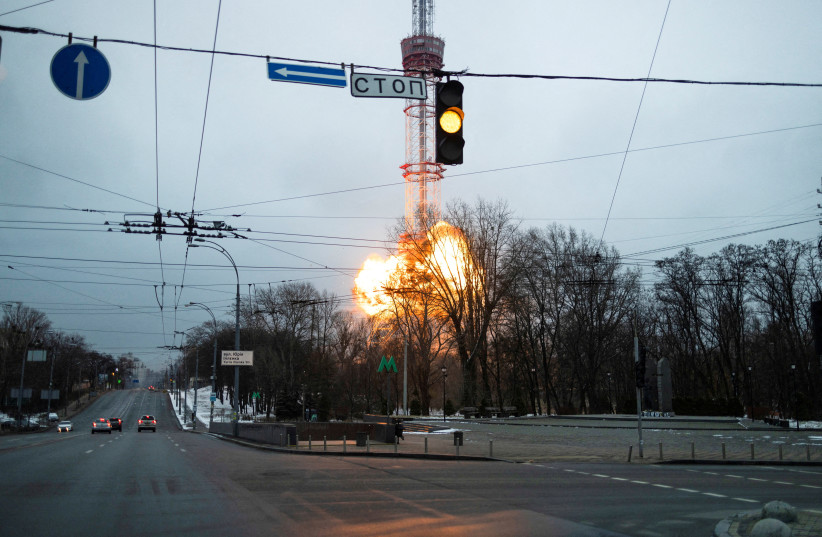Four weeks ago, a Russian missile struck Babyn Yar, a ravine outside Kiev, killing a number of people.
Amid the many horrors of war, what makes this attack particularly contemptible? The answer is a number: 33,371. That’s how many Jews were shot to death by Nazi forces at Babyn Yar over two days in 1941. It is important that such events not be reduced to abstractions, but remembered for all their specificity, numbers and all.
Babyn Yar’s history speaks to both erasure and preservation. First, it was the Nazis, burning the bodies in order to displace the memory of those killed. Then came the Soviets, who tried to fill in the ravine in 1961. In time, Holocaust survivors gathered at the physical site, holding makeshift memorials. It wasn’t until 1991 – five full decades after the slaughter – that the Babyn Yar memorial was finally erected. Now, this site is imperiled again, caught in the too-frequent horrors of war.
Sacred sites such as these are a cornerstone of Jewish heritage and it is that memory that many have sought to erase and many others have fought to protect.
On the eve of Yom Kippur – the holiest day of the Jewish year – innocent women, children, and elderly were gathered near a Jewish cemetery, then made to stand in the ravine, before being gunned down. In that fashion, 33,371 lives were taken over the course of two days, marking the largest massacre in the history of the Holocaust. Another 70,000 were massacred in the same site in the same manner over the next two years.

Contemporary attempts at erasure tend not to involve missiles and armaments. The methods are more pernicious. Consider the work of the Boycott, Divestment and Sanctions (BDS) movement. Their goal: the dissolution of the nation of Israel. Their methods: campaigns of anti-Israel propaganda, public pressure, and the proliferation of antisemitic rhetoric.
“[Jews] are not a people,” Omar Barghouti, a co-founder of the BDS movement, once declared. As part of his and his supporters’ demonization and delegitimization of Israel, they attempt various forms of historical erasure – including arguing that the Jewish people ought to be denied the universal right of self-determination and that the nation of Israel should be destroyed.
BDS literature warps history to its ends, principally by arguing that the Jewish people have no millennia-old ties to Israel and that the Jewish state ought to be dismantled. Of course, they grossly distort the past, but perhaps more troubling is their willingness to ignore modern Israel’s pivotal role as a sanctuary for Jewish and non-Jewish people alike.
This was reinforced just weeks ago: Israeli leaders announced that they would expand eligibility for both non-Jewish and Jewish Ukraine refugees of the war by 25,000. “The sights of war in Ukraine and the suffering experienced by its citizens rattle the soul and don’t allow us to remain indifferent,” declared Interior Minister Ayelet Shaked. (Perhaps unsurprisingly, a prominent BDS organization criticized this act of decency as an “incoming wave of Zionist colonization.”)
Israel’s mercy flows from its stark memory of atrocities – which is why the preservation of memorials and grave sites matters. Just as the BDS movement attempts to rewrite the history of the Holocaust and of Israel, so must others work to preserve the places and memories of what happened, and explain that past to new generations.
At urgent, fraught moments, it’s easy for us to ignore the work of preservation. But, we have an obligation, as ever, to protect sites such as Babyn Yar. Just as the indiscriminate killing of civilians ought to be condemned, so must the world speak up in defense of heritage sites, monuments and other testimonials.
The last words on this matter ought to belong to the Russian poet Yevgeny Yevtushenko, whose poetry has ensured that Babyn Yar’s legacy lives on. At the time of his writing, there was no physical memorial and no informal gatherings of survivors. “At Babyn Yar,” he wrote, “there’s rustle of wild thyme. The towering trees look down so sternly in their judgment. And all the silence screams.”
His words call us to action – to protect these sites and the memory of those they honor, especially in the face of others who seek to desecrate the past to serve their own ends.
The writer is the former chairman of the Commission for the Preservation of America’s Heritage Abroad.
